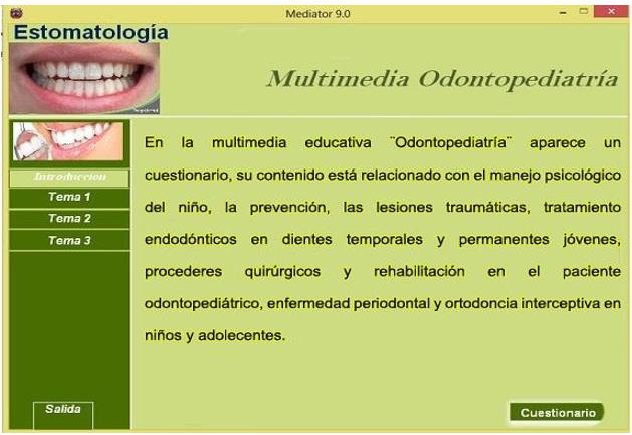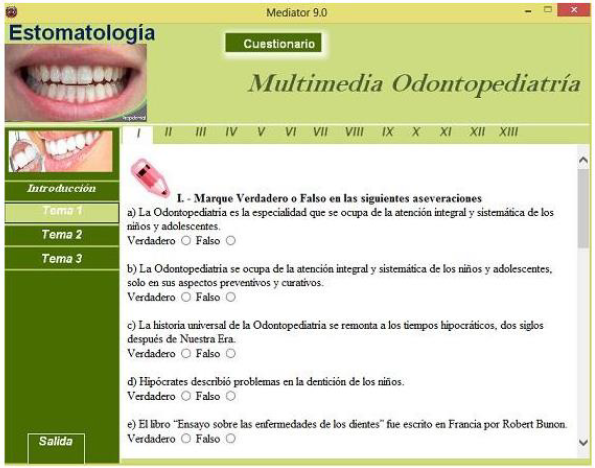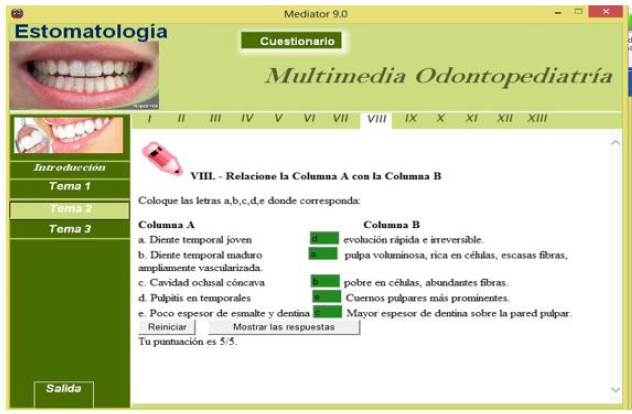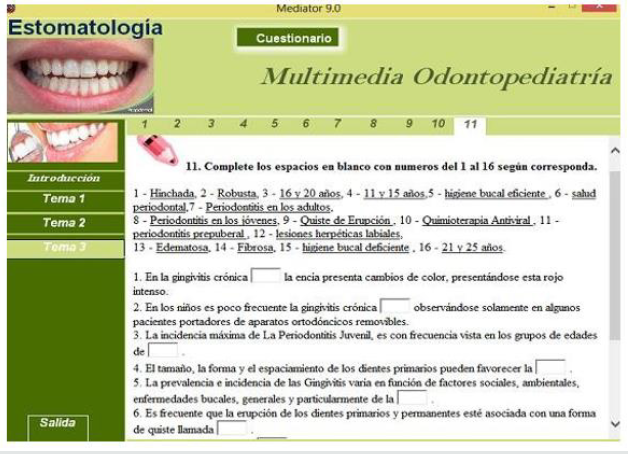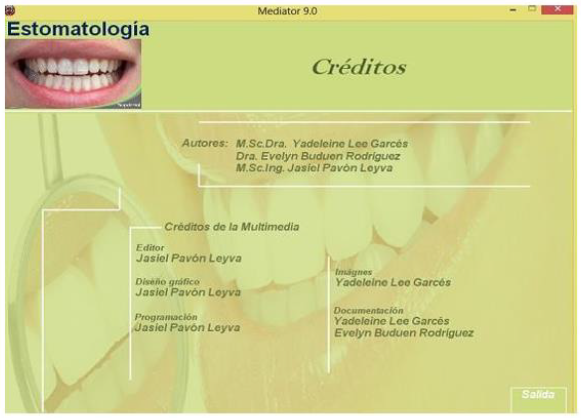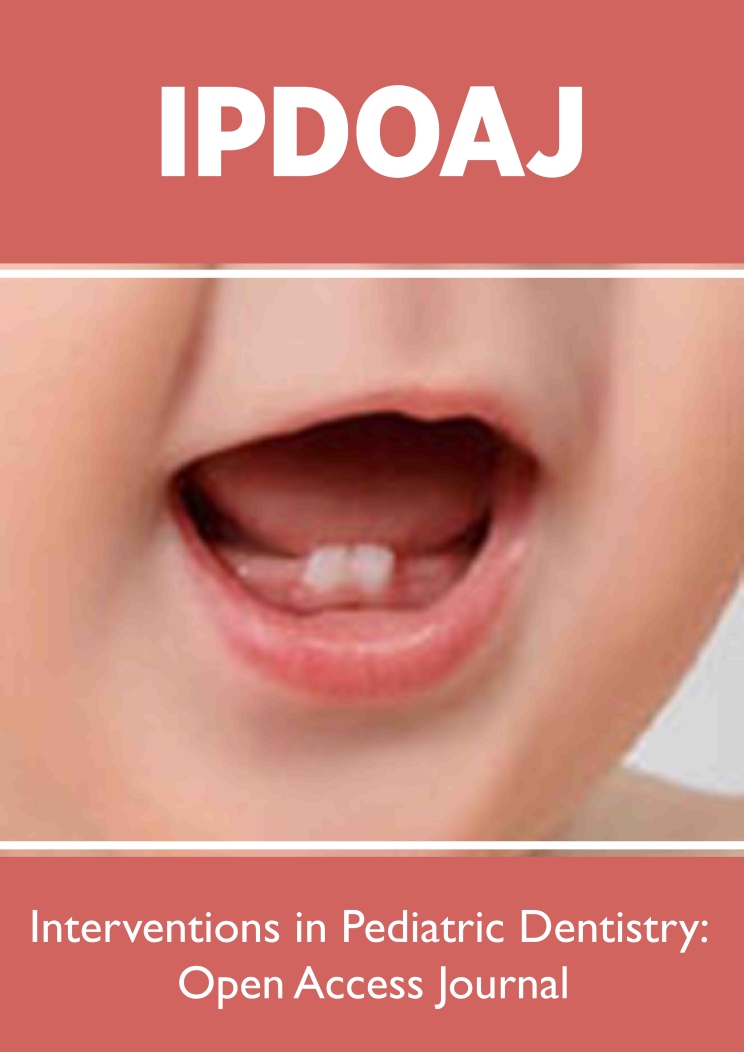
Lupine Publishers Group
Lupine Publishers
Menu
ISSN: 2637-6636
Review Article(ISSN: 2637-6636) 
Multimedia educativa “Odontopediatría” Educational multimedia “Pediatric Dentistry” Volume 5 - Issue 3
Jasiel Pavón Leyva1*, Yadeleine Lee Garcés2
- 1Center for Technological Applications for Sustainable Development (CATEDES), Guantanamo, Cuba
- 2University of Medical Sciences, Guantanamo, Cuba
Received:January 12, 2021; Published: January 21, 2021
*Corresponding author: Jasiel Pavón Leyva, Center for Technological Applications for Sustainable Development (CATEDES), Guantanamo, Cuba
DOI: 10.32474/IPDOAJ.2021.05.000215
Abstract
An educational multimedia was made that is proposed as a means of teaching for the exercise in the classes of the subject Pediatric Dentistry of the Stingology career of the University of Medical Sciences of Guantanamo, which allows a better understanding of the contents related to the psychological management of children, prevention, traumatic injuries, endodontic treatment in temporary and permanent young teeth, surgical procedures and rehabilitation in the dental patient, periodontal disease and interceptive orthodontics in children and adolescents. The structure was formed as follows: it begins by showing the cover with a brief introduction of what is intended of the multimedia, then the contents to be addressed reflected in three questionnaire-like topics, with their e.g., ercicios, connected with hyperlinks between them and when the credits come out.
Keywords: Stomatology; pediatric dentist; educational multimedia
Introduction
The use of the computer is a topical topic in the educational field, both globally and in the country, in most cases it is considered as an ideal way to solve the learning problems presented by students, because it allows access to a considerable amount of information, presented in different formats (written, sound and visual) or the combination of these, as well as a valuable interactivity of the student with the medium, through the technological product [1] (Figure 1). Today there are dissimilar conditions to raise the quality of learning. Software and textbooks are used; but we need to know how to use these means and resources to achieve the development of the practical skills needed; teachers must better prepare based on their correct use [2] (Figure 2). The means of teaching are a fundamental factor in the preparation of future specialists in Stomatiology, for the development of knowledge, skills and skills. In the subject of Pediatric Dentistry students must appropriate many of them to achieve better learning [3]. To prepare in this regard, they must have well-updated means of teaching depending on maintaining the oral health of patients (Figure 3). In the teachinglearning process promoted in the subject Odontopediatría, from the career of Stomatitology at the University of Medical Sciences of Guantánamo, difficulties in learning students on the contents related to the psychological management of the child, prevention, traumatic injuries, endodontic treatment in temporary and permanent young teeth, surgical procedures and rehabilitation in the dental and pediatric patient, periodontal disease and interceptive orthodontics in children and adolescents for the development and execution of the activities they will perform once graduated, all of which limit the purposes and objectives to be achieved [4]. Considering these budgets, the following objective is stated: to develop an educational multimedia for the subject of “Pediatric Dentistry” that allows to consolidate the contents and acquire the skills and skills that the student needs in this subject by solving several questionnaires (Figure 4).
Development
Several authors suggest that the educational teaching process currently taking place in the Faculties of Stomatiology in Cuba, it should be revised, since both the predominant educational model, as well as the contents of the curriculum, are outdated with regard to the development of ICT ; that is, they do not respond to recent scientific and technical advances, to new expectations for the improvement of the technical and human quality of health care [5]. Neither the teachers study them, nor the teachers use these latest generation media in their entirety. In addition, the authors of this multimedia share Luengas view that the consolidation of the ethical values to be developed in professionals during their training process must also be considered [6]. One of the subjects you need from this review is Pediatric Dentistry, which is within the integrative discipline of curriculum D. Plan D of the career of Stomatitology is designed in such a way that it allows to obtain an egress that is able to carry out comprehensive attention to the population characterized by actions of health promotion, prevention of diseases of the maxyl-facial complex, as well as that it provides the necessary tools for the diagnosis and timely treatment of these referral to the second level of care where required (Figure 5).
The way of organizing the main teaching in which you can
achieve the objective is Education at work where the student learns
by doing, however, we help ourselves with dissimilar means of
teaching such as x-rays, photographs, study models, use of videos
and powers point on the computer etc. Today’s reality imposes a
challenge: applying information and communication technologies
to teaching, thus helping to develop a scientific methodology in
educating based on controversial situations that allows them
with a simple approach to interpret and resolve real or simulated
situations. In view of this situation, it is necessary to ask: Are the
Faculties of Stoitology prepared in Cuba to take on the current
challenges imposed by technological advances to develop the new
curriculum (Plan D)? Is the program of the subject Odontopediatría
structured using the latest generation means? Do students and
teachers have sufficient mastery of ICT for the development of the
teaching process learned from the contents through these new
technological advances? The New Communication and Information
Technologies, so-called TICs, allow the development of various
technological tools to answer the questions that are raised among
which are multimedia.
They integrate different media such as visual, auditory and
haptics into a single application. These characteristics are the ones
that allow it to be used most frequently in the teaching process to
learn about both undergraduate and postgraduate. The multimedia
proposal is based on the structure, which will allow to obtain a
relevant tool according to the target population, target to which
it is aimed. The Pediatric Dentistry has different characteristics
than other subjects because it is based on the attention of the child
population, so the student has to acquire knowledge, develop skills
and values that allow him to identify the different clinical cases and
problems situations presented to him to make safe diagnoses and
appropriate treatments. Multimedia will be a means of teaching
and a technological tool of the latest generation that contributes to
the student’s achievement of the overall objectives of the subject;
for example, you can identify different pathologies such as Chan
and Rodríguez [7], in this case by observing images, which lead
to a specific diagnosis and treatment of the case, in addition to
inferring differential diagnoses. So, it integrates knowledge, skills
and consolidates values so necessary in the care of the under-19s.
The images, text (content), audio, and exercises of multimedia
questionnaires, are in line with the purpose of their creation, is of
cir, the learning of students and the consequent change in clinical
performance and skills expected in the professional future [8-11].
The product presented has a logical order and is easy to handle
by the user, who once sits in front of the machine and operates
the equipment to access the multimedia, Just clip the executable
“Multimedia.exe” to read the presentation or cover where they
appear: to the center, a brief introduction of what is addressed in the software, the first screen, which is the mother screen, is displayed
from here you navigate to the other parts of the program; the
same pattern the different topics that are addressed, the minimize
and close buttons at the top right, and the output button on the
lower left pair (Figure 1). The product has instrumental music
and has a user manual [12-14]. In the educational multimedia
“Odontopediatricría” a questionnaire appears, its content is related
to the psychological management of the child, prevention, traumatic
injuries, endodontic treatment in temporary and permanent young
teeth, surgical procedures and rehabilitation in the dental-pediatric
patient, periodontal disease and interceptive orthodontics in
children and adolescents. When accessing the different slides, the
user will find links that, by clipping them, will allow them to find
the information they need, move backwards, continue browsing or
simply leave the product if desired.
For the use of multimedia, the procedure is very simple, you only
have to copy it to the computer and run it through the executable
mentioned above: “Multimedia.exe”. The topics contained in the
product are divided into three, each of which has a questionnaire
consisting of a number of exercises ranging from 13 to 15. Questions
of true or false, links, completeness, and chronological order
appear in each question. For each of the responses, the system
displays a score that indicates which ones are correct and which
are incorrect. The first topic addresses exercise on the history of
Pediatric Dentistry, the foundation, the precursor to it; how parents
and family members approach their children’s Stomatological
treatment; management techniques for conduct a control in the
dental-pediatric patient, physical restriction techniques; Matzukubo
technique, Dari screen technique, the use of fluorides, cyst statics,
dent bacterial plaque, pulp coating, cavity varnishes, form cresol and
calcium-gone hydrox. The second topic concerns operating actions
in young temporary and permanent teeth, the characteristics of
this, the advantage of tunnel cavities, physurotomies, lastia am lop,
preventive restorations, pulp chambers, the concave occlusal cavity,
the pulp amputation technique and pulpotomy. The third topic
exposes minimally invasive techniques, loss of space in arcades,
elimination of occlusal interference, physurotomies, amyloplast,
chronic edematous gingivitis, chronic fibrous gingivitis, rash
cyst, and antiviral chemotherapy. At the end of the credits of the
multimedia, where the names and surnames of the authors of the
product and their scientific category are reflected.
Results and Discussion
The multimedia was put into practice with the fourth-year students of the Stomatological Clinic Julio A Mella, for a period of one year, to check its feasibility as a means of teaching, it complies with the principle of hierarchy and integrity, is coherent and affordable. The following clinical case is analyzed to verify its usefulness. 9-year-old girl. APF: The mother refers that there is no member in her family who has this anomaly. APP: the girl does not suffer from systemic diseases; but sometimes has chalk being allergic to dust and often cannot breathe through the nose. About 21 days ago he fell at school while playing in the garden and his previous teeth suffered tissue leaks that compromised enamel and dentin. The extrabucal examination reveals a convex profile, short, hypotonic upper lip, and a strengthening of the chin tassel muscle when ordered to close the mouth. Whenre-alizing the intrabucal examination is a highlight of 6 mm, exceeds 1/3 crown. Ratio of disto occlusion molars, diastemas between the upper incisors. The terminal plane of the second temporal molars in distal step. Loss of normal co-loration of 11 and 21, presents visible coloration in brownish crown. In 84 and 75 white spot that does not retain the explorer towards distal and mesial rims respectively, but which responds to contact with sweet foods and before cold water hot como refers the girl. The girl practices proper oral hygiene but the marginal gum of the anterosuperient teeth is somewhat swollen and with bleeding at the slightest stimulus, the patient does not have tooth decay.
Students were asked to respond to this clinical case:
a) Is this type of malocclusion preventable? If yes, please
mention some measures that would help prevent this
dentomaxilofacial anomaly.
b) What are the diagnostic methods you would use to arrive
at a diagnosis in this case?
c) Is the trauma of the previous teeth common in these types
of patients and why?
d) Diagnose the traumatic injury present in 11 and 21.
Explain what behavior, both mediate and immediate, you would
take with both.
e) Diagnose lesions in 84 and 75 and say what characteristics
you should ensure in your treatment to avoid excessive
aggression to the dentinopulpar complex.
f) Why is there gingival inflammation if the patient is correct
oral hygiene?
g) Is it necessary to inter consult with other specialties?
Explain.
It was shown that multimedia is based on the materialistic dialectical conception of the world and has as its theoretical basis the Didactics, hence the process of teaching – learning subject to laws and as a dynamic activity that needs to be considered at every historical moment in correspondence with the development achieved by society. Aim for the methodological projection of the teaching that the teacher can plan to direct the learning of the students, starting from this itself and the characteristics and possibilities of the contents addressed in it. The Multimedia “Pediatric Dentistry” was generalized through its implementation in the Stomatological Clinic Lidia Doce and Departments of Stomatology of the Teaching Polyclinics of the Guantanamo Province. 100% of the teachers interviewed agree that the multimedia Educational “Pediatric Dentistry” is valid, because it allows the systematization of the contents related to pediatric dentistry for students of the stomatithology career of the University of Medical Sciences of Guantánamo, also makes it possible to direct the learning teaching process, promotes the realization of independent work, stimulates the creativity of students and solves a problem of socio-educational practice in the career, since there are no multimedia methods to treat this content. Students and teachers consider multimedia to be easy to manipulate and allow the apprehension of information in a clear way, through the use of a technical language absent from verbal stereotypes.
Conclusion
The educational multimedia “Pediatric Dentistry” complies with the principle of hierarchy and integrity, is consistent and affordable, is valid and feasible to consolidate the contents and acquire the skills and skills that the student needs in this subject.
References
- Bravo C (1997) Course 25 Pedagogy 97 IPLAC C The use of the computer as a means of teaching. Havana.
- González Castro Vicente (1992) Theory and practice of the Teaching Media. Editorial Pueblo y Educació Havana.
- Aragon Castro Aker (2016) Light Printing. Current situation and perspective of Dental Education. Lecture given in the workshop of the Center for the Study of Professional Pedagogy of ISPETP Havana.
- Abreu Regueiro (2017) Roberto Professional Pedagogy, Magnetic support, A proposal open to reflection and debate. ISPETP, Havana.
- Lara Castellanos (2016) People and Education Learn and Teach at School. Havana.
- Luengas Aragonés J (2015) Methodological guidelines for working with audiovisual media. Methodological Meeting of the Vice Rector of Undergraduate. Dept. Media de Enseñ Isp. Guantanamo.
- Chan J (2017) Design of an Educational Multimedia Tool: The Relevant Physiological Anatome Conditions of the Oral Cavity of the Bruxist Patient. Undergraduate thesis, UNED, Costa Rica.
- Castro Ruz, Fidel (1999) The study, work, and formation of youth. Selection of texts, Havana, Office of Publications of the State Council.
- Cala Marlene (2015) Multimedia on fruit propagation. Guantanamo: technology product.
- Gonzalez-Manet E (2015) The new era of computer technologies. Rev Education Not 84. Cuba.
- Hernández Aragonés José Carlos (2018) The Use of Teaching Media in the Learning Process.
- Maroto O, Quirós M (2017) Design of an Educational multimedia tool to Facilitate the Learning Process in the Restoration Course II of the Faculty of Dentistry of the University of Costa Rica. Undergraduate thesis, UNED, Costa Rica.
- Ortega M, Gurrola B (2016) Application and use of interactive programs in Dentistry.
- Rivero A (2017) The use of the computer as a means of teaching, course 25 Pedagogy 97 IPLAC C Havana.
Editorial Manager:
Email:
pediatricdentistry@lupinepublishers.com

Top Editors
-

Mark E Smith
Bio chemistry
University of Texas Medical Branch, USA -

Lawrence A Presley
Department of Criminal Justice
Liberty University, USA -

Thomas W Miller
Department of Psychiatry
University of Kentucky, USA -

Gjumrakch Aliev
Department of Medicine
Gally International Biomedical Research & Consulting LLC, USA -

Christopher Bryant
Department of Urbanisation and Agricultural
Montreal university, USA -

Robert William Frare
Oral & Maxillofacial Pathology
New York University, USA -

Rudolph Modesto Navari
Gastroenterology and Hepatology
University of Alabama, UK -

Andrew Hague
Department of Medicine
Universities of Bradford, UK -

George Gregory Buttigieg
Maltese College of Obstetrics and Gynaecology, Europe -

Chen-Hsiung Yeh
Oncology
Circulogene Theranostics, England -
.png)
Emilio Bucio-Carrillo
Radiation Chemistry
National University of Mexico, USA -
.jpg)
Casey J Grenier
Analytical Chemistry
Wentworth Institute of Technology, USA -
Hany Atalah
Minimally Invasive Surgery
Mercer University school of Medicine, USA -

Abu-Hussein Muhamad
Pediatric Dentistry
University of Athens , Greece

The annual scholar awards from Lupine Publishers honor a selected number Read More...




